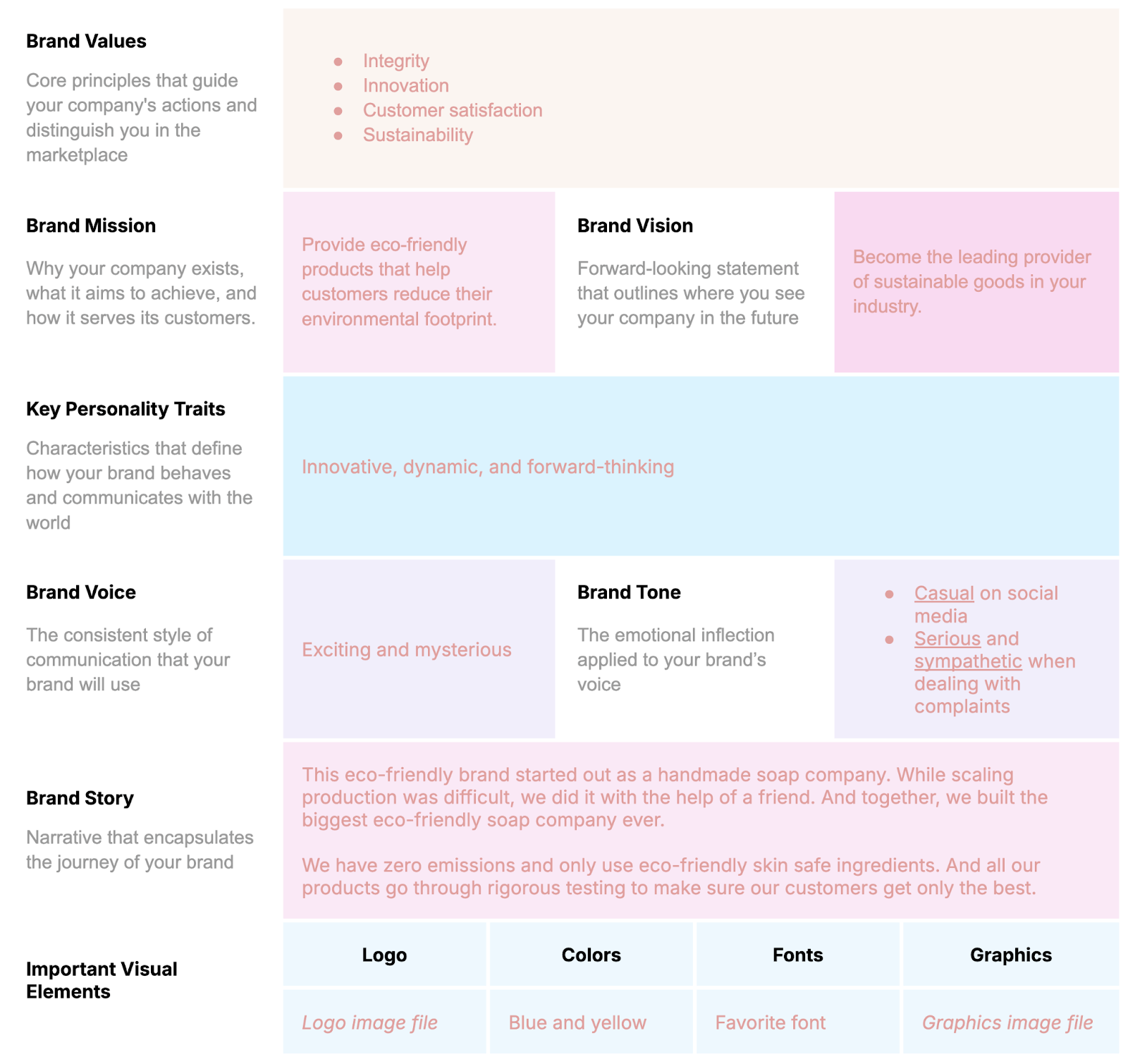brand-persona">What Is a Brand Persona?
A brand persona is the personification of a brand’s identity—its mission and vision, values, personality traits, tone of voice, and core characteristics.
It documents how consumers would perceive a brand if that brand came to life as a human being. And how a brand would act and communicate with consumers through customer service, social media, and other channels.
For example, an eco-conscious company might have a brand persona defined by the information below:
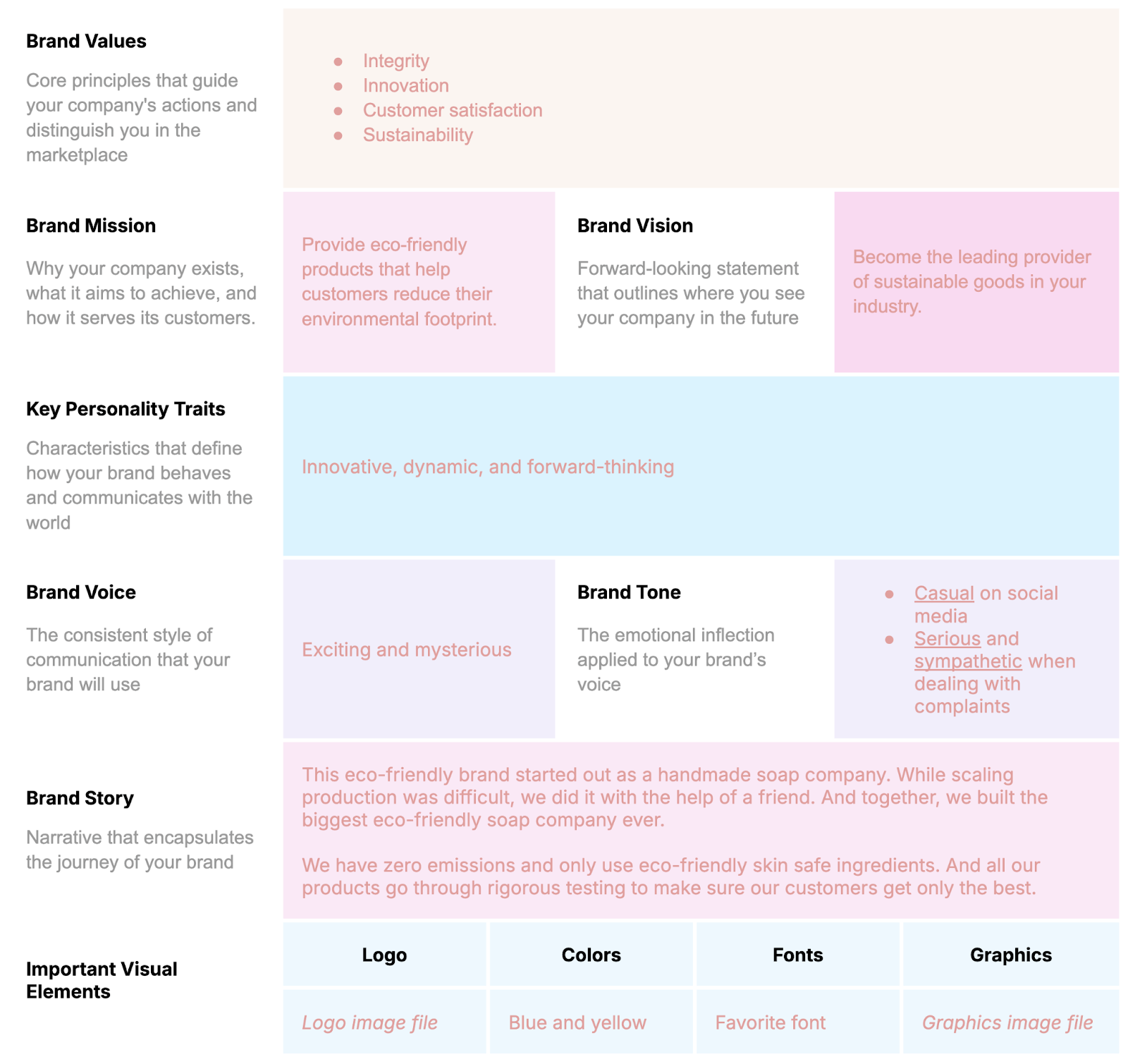
By developing a well-defined brand persona, companies can ensure brand consistency, differentiate themselves from competitors, and build deeper emotional connections with their audiences.
Your brand persona should act as a guiding light for things like:
- Visual identity and design
- Marketing messaging and copywriting
- Social media personality
- Customer service interactions
- Product design and packaging
For example, most people perceive Apple’s brand persona as design-obsessed, simplistic, modern, and exclusive.
Their minimalist aesthetics, aspirational ads, and premium pricing all align with this persona.
Brand Persona vs. Brand Identity
A brand persona and brand identity are closely related but distinct concepts.
Here’s how they differ:
A brand identity refers to the visual and tonal elements that make a brand recognizable and distinct. This includes things like the logo, color palette, typography, tagline, and overall visual aesthetic.
For example, you can immediately tell that McDonald’s made the items below. Based on the colors, tagline, and icons they used.

Image Source: Ad Age
A brand persona goes a step further by humanizing and personifying the brand’s identity and values.
A brand persona would answer things like:
- Is the brand’s voice straightforward and professional or more witty and casual?
- How would the brand respond to a customer complaint?
- What kinds of social causes would it support?
It fleshes out the brand’s personality traits, voice, and mannerisms as if it were an actual person.
For example, a brand’s identity may specify using a bold, sans-serif typeface and vibrant jewel tones in its visuals. The persona would dictate how that bold visual identity would “speak” and “behave” across various contexts.
Brand Persona vs. Brand Personality
Brand personality is the set of human characteristics a brand conveys (one part of the brand persona).
Examples of brand personality traits include:
- Friendly and approachable (Dove)
- Rugged and adventurous (Jeep)
- Sophisticated and glamorous (Chanel)
This 3D ad from Jeep, for instance, clearly displays the brand’s adventurous personality. The ad shows the Jeep Wrangler 4xe driving in the forest, over water, and then smashing through the screen.

A brand persona builds on these traits, fleshing them out into a more comprehensive, humanized profile. It creates a fuller picture by adding details like:
- How they would communicate and interact
- What they value and believe in
- What their mission is
- What their backstory is
Brand Persona vs. Buyer Persona
A buyer persona is a detailed profile of your ideal customer.
It includes their demographic information, interests, pain points, buying behavior, and motivations.
Example (created with Semrush Persona):
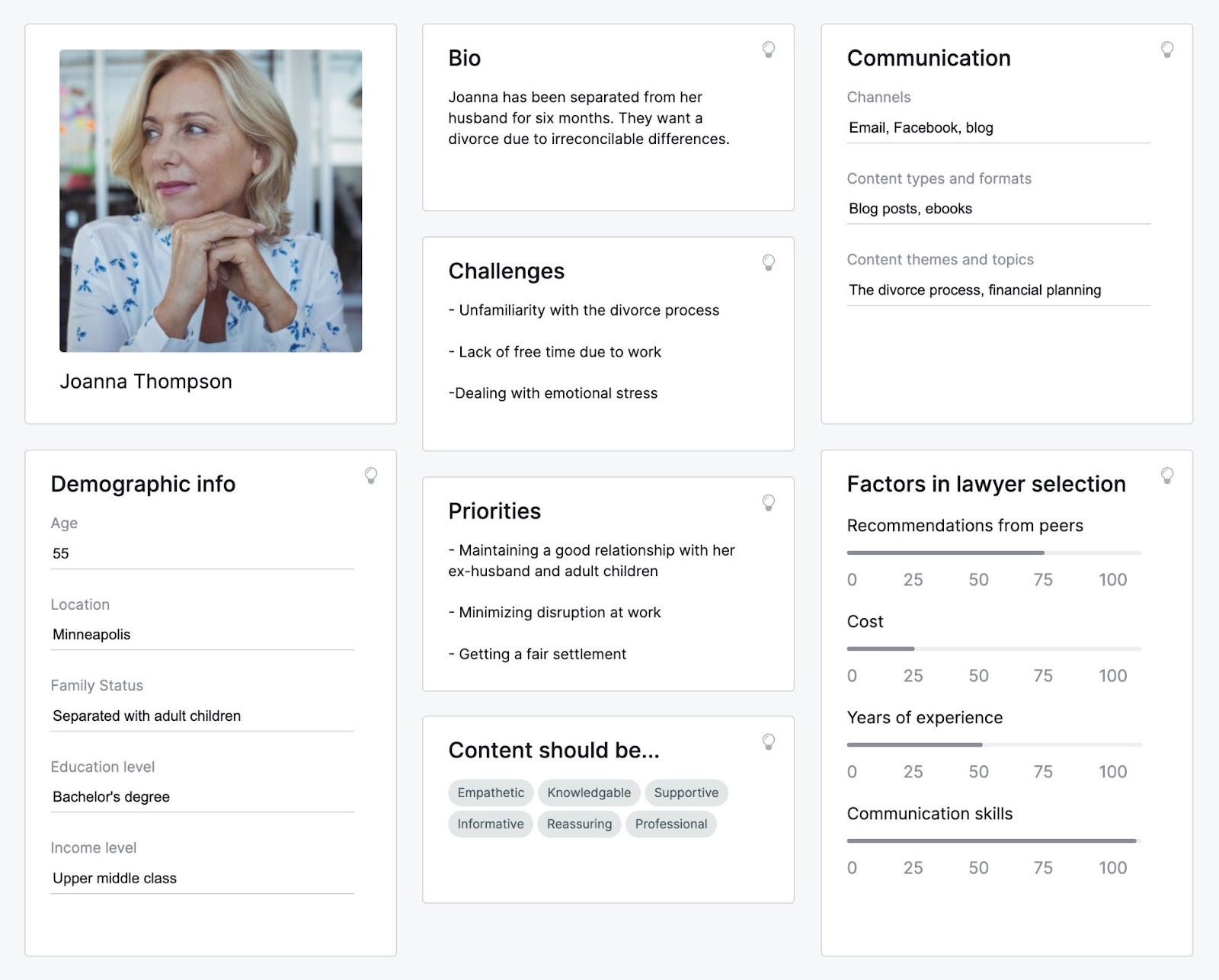
The purpose of a buyer persona is to help you understand your customers better. So you can tailor your products, services, and marketing efforts to meet their needs and expectations.
In contrast, the brand persona represents your company’s own persona that customers can relate to.
The two work together—you build buyer personas to deeply understand your customers, then craft a brand persona that can help engage with them in a human, personalized way through every interaction.
Both are essential for running a successful business.
Brand Persona vs. Mascot
A mascot is a character or symbol designed to represent a brand visually and emotionally. It is often used in marketing to connect with audiences.
For example, Cheetos’s Chester Cheetah is a playful mascot that personifies the brand’s silly and fun personality.
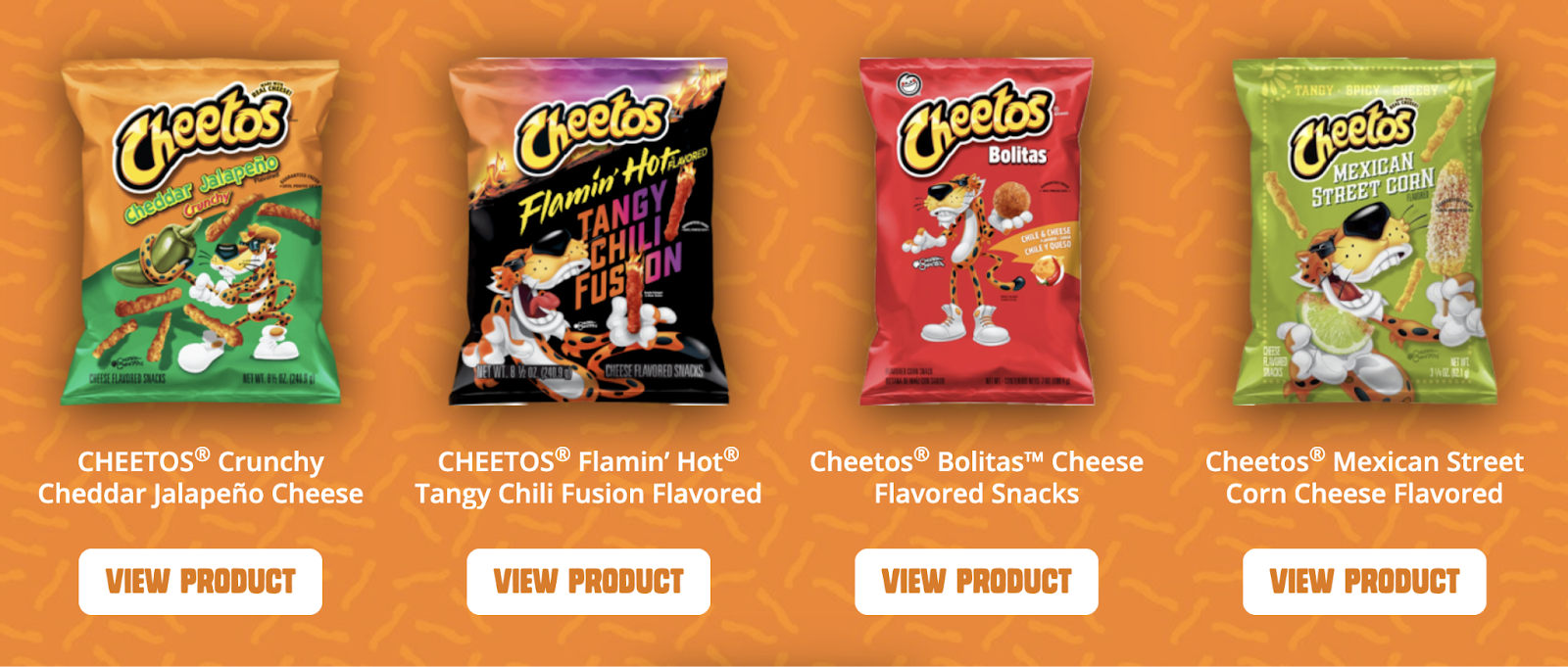
While a mascot might be the face of the brand in advertisements, the brand persona is the company’s identity. It guides every interaction with its customers and shapes the brand’s overall image.
Why Is a Brand Persona Important?
Having a well-defined brand persona is crucial for a brand’s success. Here’s why:
It Builds Trust and Loyalty
A brand persona builds trust and loyalty with your customers over time.
When your brand messaging, visuals, and customer interactions align with the persona’s established traits and values, it creates a unified experience customers can depend on.
This strengthens their connection to your brand and keeps them coming back.
It Differentiates Your Brand
In a competitive market, a unique brand persona can set your brand apart from others.
By humanizing your brand with distinct personality traits and values, you create an identity customers can emotionally connect with.
A well-crafted persona differentiates your brand from competitors and makes it more engaging.
It Enables Consistent Communication
A brand persona guides all forms of communication from the brand.
Whether it’s social media posts, email newsletters, or customer service interactions, having a brand persona makes it easy to maintain a consistent voice and messaging.
This consistency reinforces the brand’s identity and helps to build a strong connection with the audience.
How to Create a Brand Persona in 7 Steps (+ Template)
Create a brand persona that resonates with your customers by first understanding their needs.
And then building your brand’s values, mission, personality, tone, and story based on someone your potential customer can relate to.
Use this brand persona template to follow along.
1. Understand Your Target Audience
Your target audience consists of people who are likely to be interested in your products or services.
To create an effective brand persona, you need an in-depth understanding of your audience. Only then can you create a brand persona that resonates with them.
What do you need to find out about your target audience?
- Demographics: This includes their age, gender, location, etc.
- Socioeconomics: This includes their income, education, employment status, etc.
- Behavior: This includes their interests and how they consume information online.
To get this information, use Semrush’s One2Target tool.
Open the tool, enter your domain name, and click “Analyze.”
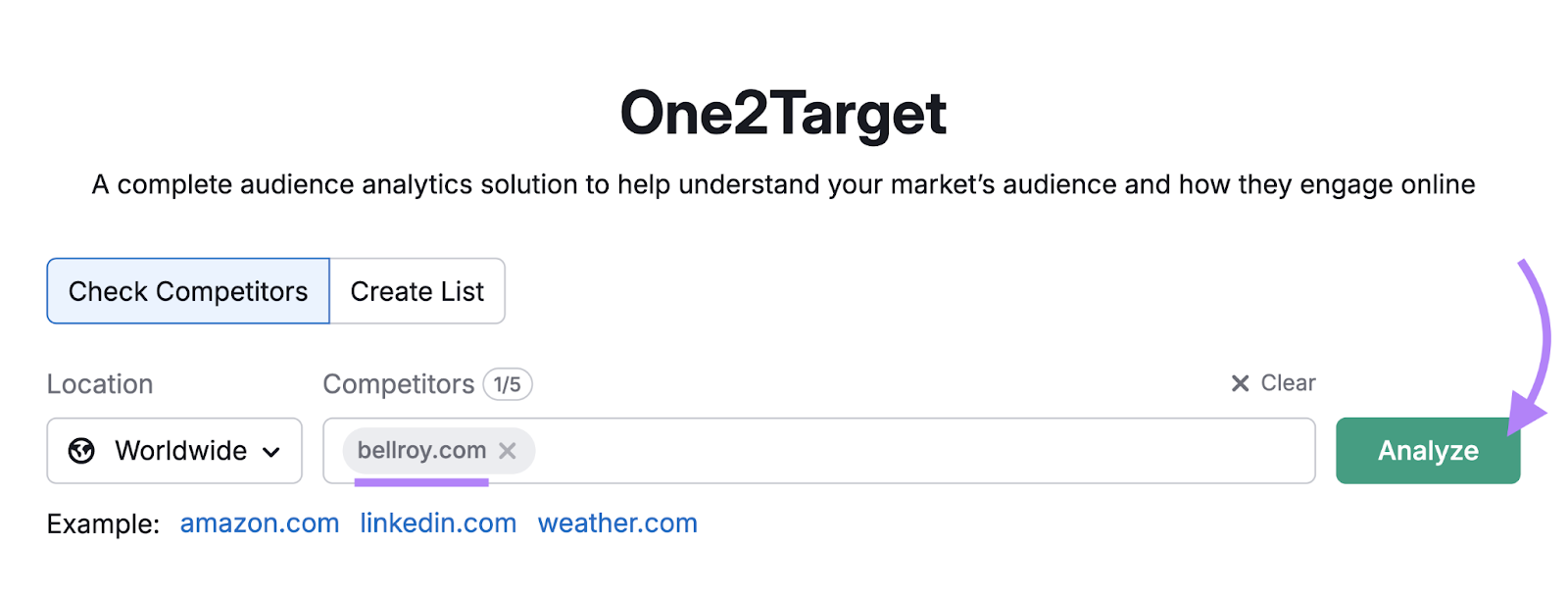
In the “Demographics” tab, you’ll see your audience’s age, gender, and location:
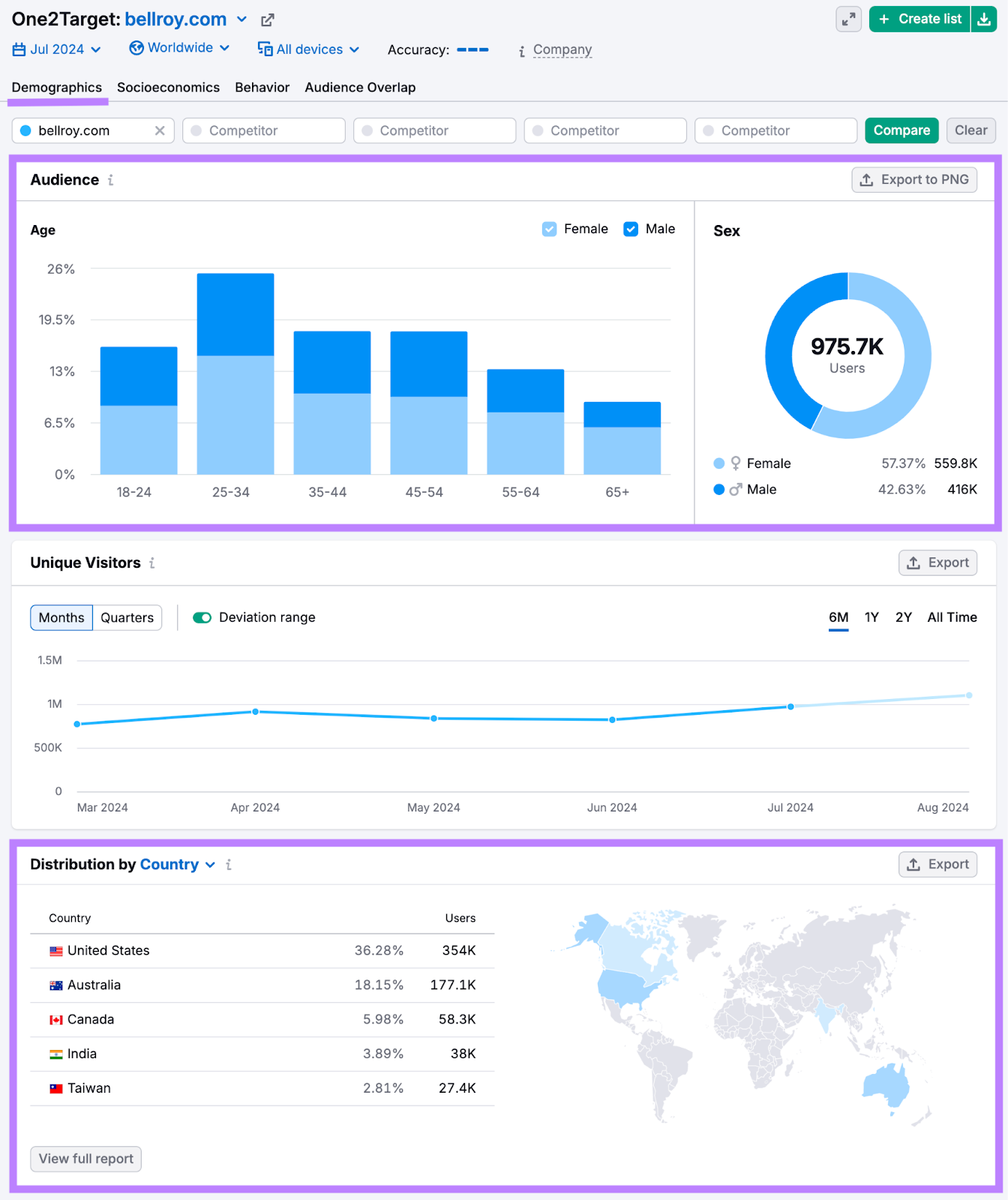
Click on the “Socioeconomics” tab to find your audience’s household size, income level, employment status, and educational background.
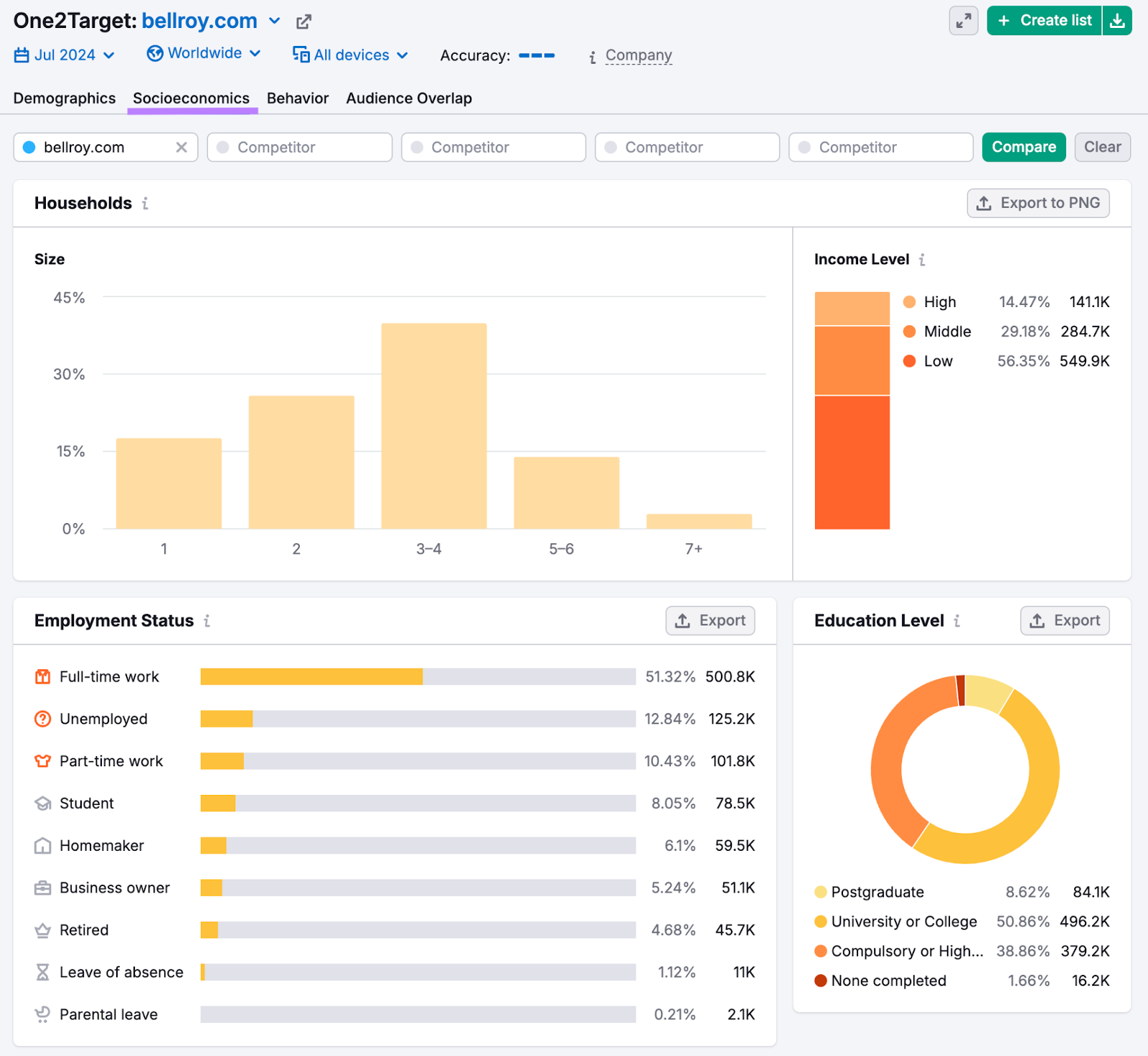
Go to the “Behavior” tab to see your audience’s interests and the social media platforms they use to consume information.
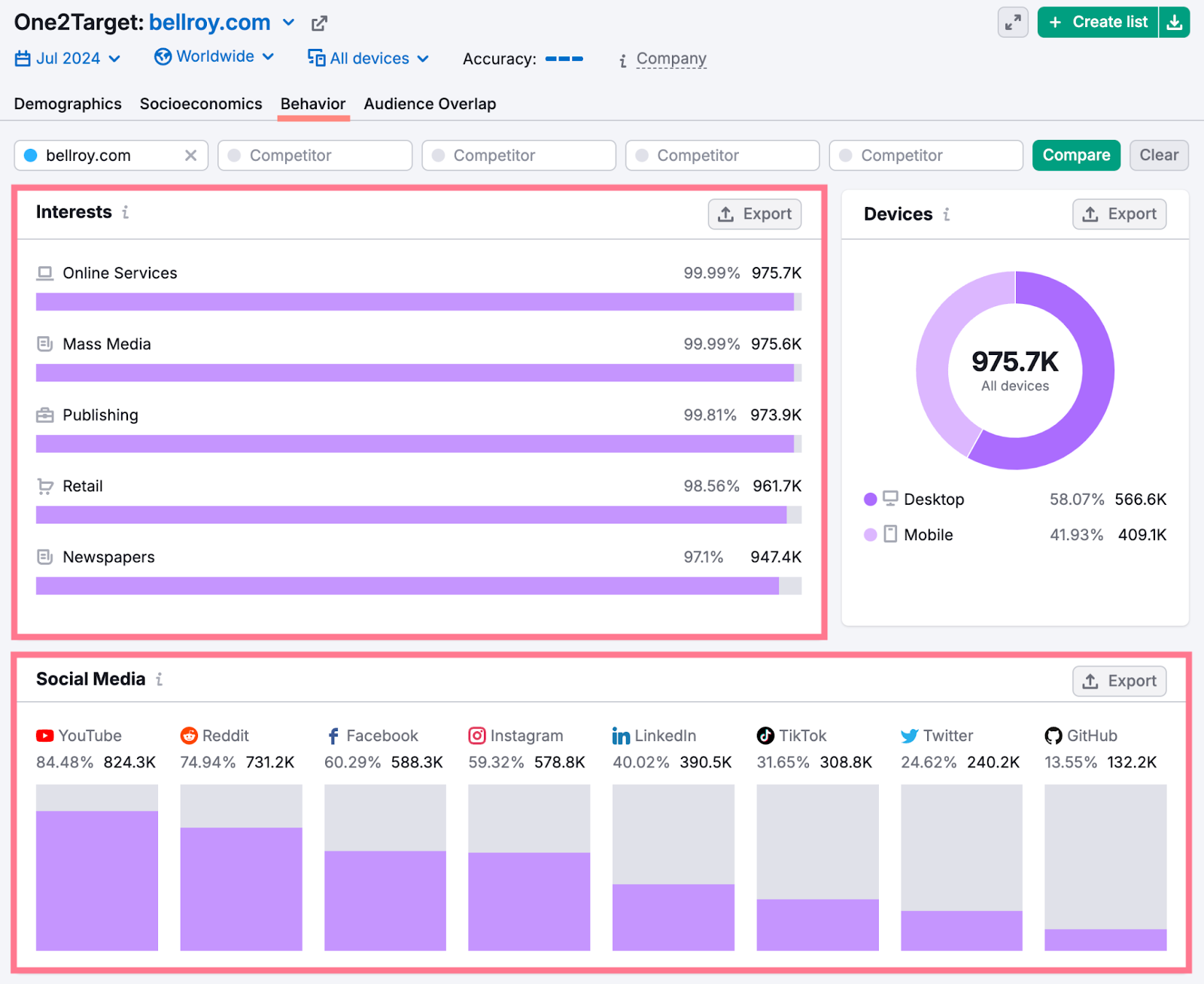
Use this information to fill out your brand persona template.
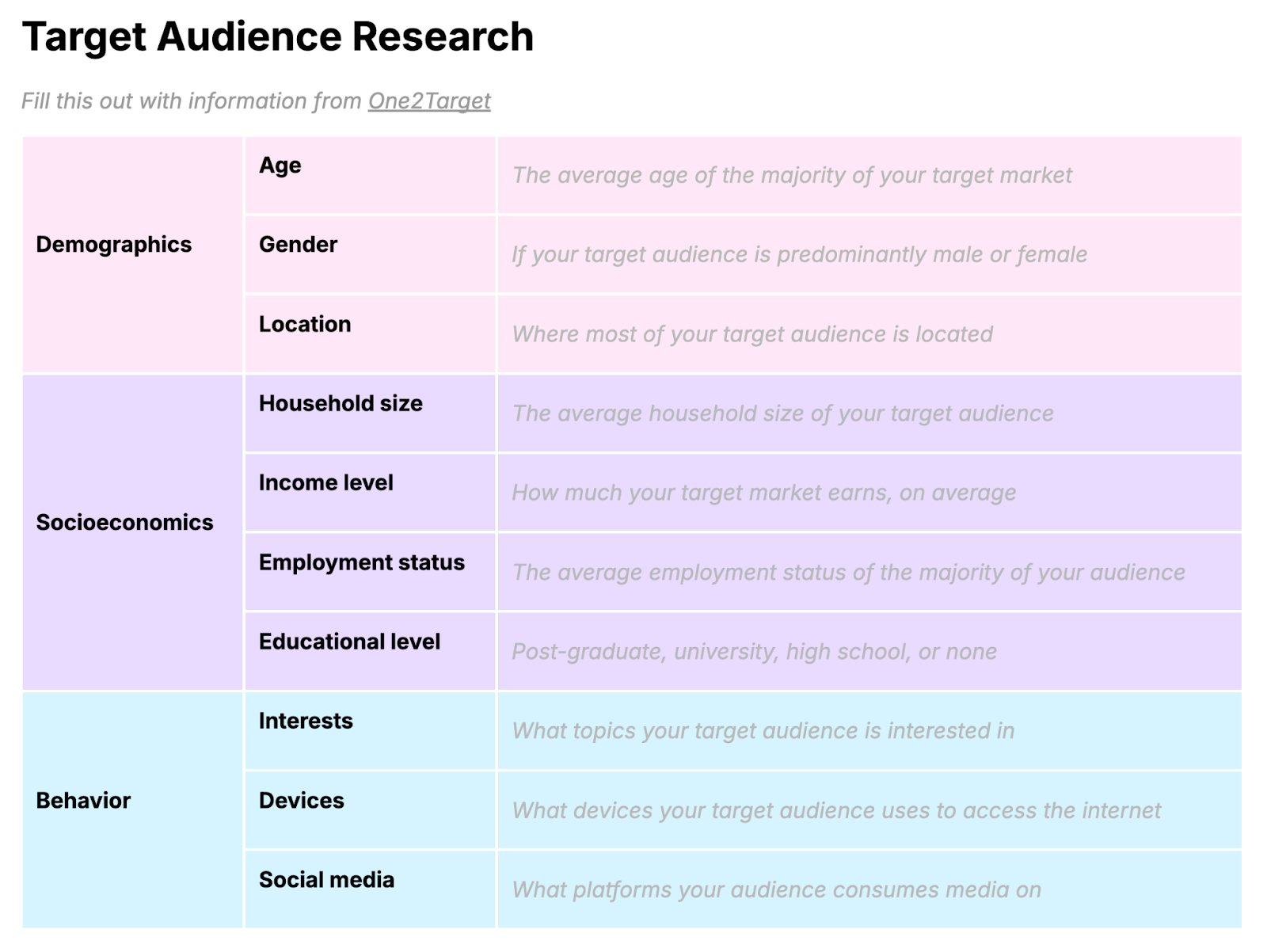
And use this knowledge to better understand your audience’s characteristics and preferences. So that you can create a brand persona that aligns with them.
For example, if your audience is predominantly young, tech-savvy individuals with a high level of education and a strong interest in environmental sustainability, your brand persona could be forward-thinking, innovative, and eco-conscious.
2. Clarify Your Brand Values
Your brand values are the core principles that guide your company’s actions and distinguish you in the marketplace.
Every aspect of your brand persona should reflect your brand values.
To identify your core principles, ask yourself the following:
- What does your company stand for?
- What are the non-negotiables in the way you conduct business?
Your answers are your core principles. Add them to your template.
Some examples of core principles include:
- Integrity
- Innovation
- Customer satisfaction
- Sustainability

Once you’ve identified your brand values, ensure they’re consistently reflected in your brand persona, your marketing strategies, and your business operations.
Consistency strengthens your brand identity and builds trust with your audience.
3. Define Your Brand Mission and Vision
Your brand’s mission and vision are the guiding lights for your company’s future.
They articulate your purpose, your goals, and how you aim to serve your customers.
First, craft your brand’s mission.
This is a clear and concise statement that explains the following:
- Why your company exists
- What it aims to achieve
- How it serves its customers.
It should reflect your brand values and resonate with your target audience.
For example, if one of your brand values is sustainability, your mission could be to provide eco-friendly products that help customers reduce their environmental footprint.
Next, formulate your brand’s vision.
This is a forward-looking statement that outlines where you see your company in the future.
It’s your ultimate goal—the peak you’re striving to reach. Your vision should be ambitious yet achievable and grounded in reality.
For instance, if your mission is to provide eco-friendly products, your vision could be to become the leading provider of sustainable goods in your industry.
Once you’ve defined your mission and vision, add them to your template. And communicate them clearly to your team, your customers, and your stakeholders.

This will help everyone understand your brand’s purpose and goals. And it will ensure that your actions align with your mission and vision.
4. Establish Key Personality Traits
Your brand’s personality traits are the characteristics that define how your brand behaves and communicates with the world.
They make your brand relatable and help you connect with your target audience on an emotional level.
Here’s how to establish them:
- Identify your brand’s characteristics. Think of your brand as a person. What kind of personality would it have? Is it fun and playful, or serious and professional? Is it innovative and forward-thinking, or traditional and reliable? Identify the characteristics that best represent your brand.
- Align with your target audience. Your brand’s personality traits should resonate with your target audience. For example, if your target audience is young and tech-savvy, your brand might be innovative, dynamic, and friendly.
- Differentiate from competitors. Your brand’s personality traits should help you stand out from your competitors. If all brands in your industry are serious and professional, you might choose to be more approachable and friendly to differentiate yourself.
Once you’ve established your brand’s personality traits, take note of them.

Be consistent in expressing them across all your communications and interactions. This will help build a strong and recognizable brand persona.
5. Craft Your Brand Voice and Tone
Define your brand’s voice. This is a consistent style of communication your brand will use. It should reflect your brand’s personality traits.
For example, if your brand is fun and playful, your brand voice might be casual and humorous.
Also, determine your brand’s tone. This is the emotional inflection applied to your brand’s voice. It can change depending on the context.
For instance, your tone might be more serious when addressing a customer complaint. And it might be more cheerful when announcing a new product.
Document your brand’s voice and tone to ensure consistency across all communication channels.

This guide should include examples of do’s and don’ts for your brand communication.
Then, train your team tomake sure everyone understands your communication protocol. This will ensure a consistent brand experience for your customers, regardless of who they interact with.
6. Develop Your Brand Story
A brand story is a narrative that encapsulates the journey of your brand.
It’s the tale of your brand’s inception, its mission, the challenges it has overcome, and the milestones it has achieved.
It’s an important part of your brand persona. Because it can shape customer perceptions and make your brand feel authentic and relatable.
Here’s how to develop a brand story:
- Understand your brand’s history. Start by understanding your brand’s history. This includes when and why your brand was founded, the challenges it faced in the early days, and how it has evolved.
- Identify key milestones. Identify the key milestones in your brand’s journey. These could be product launches, business expansions, or any other significant events that have shaped your brand’s path.
- Highlight your brand’s impact. Highlight how your brand has made a difference. This could be the impact your products or services have had on your customers. Or how your brand has contributed to the community or industry.
Once you have all the elements, craft your narrative. Your brand story should be engaging, authentic, and relatable. It should evoke emotions and create a connection with your audience.

Finally, share your story. Use your website, social media platforms, and marketing materials to tell your brand story. Make it a central part of your brand communication.
7. Visualize Your Brand Persona
The final step in creating a brand persona is to develop visual elements that represent and bring your persona to life. This helps make the persona more tangible and consistent across all brand expressions.
Here are some ways to visualize your brand persona:
- Logo and colors: Develop a logo and choose colors that reflect your brand’s personality. These elements should be used consistently across all platforms to establish a strong visual identity for your brand.
- Typography: Choose fonts that align with your brand’s personality. For example, a modern, tech-savvy brand might use clean, minimalist fonts. While a traditional, reliable brand might use more classic, serif fonts.
- Imagery and graphics: Use photos, illustrations, and design styles that are consistent with your brand’s traits. These could include the types of images you use on your website, the style of your product photos, or the illustrations you use in your marketing materials.
Once you’ve developed these visual elements, create brand persona guidelines that outline how these elements should be used.

These guidelines should include details about your logo, colors, typography, imagery, and any other visual elements you use.
Brand Persona Examples
To better understand how brand personas come to life, let’s examine a few examples of companies that have successfully developed and embodied their brand identity.
We’ll look at Nike, Red Bull, and Starbucks. Each of these brands has crafted a unique persona that resonates with their audience.
Nike
Nike’s brand persona can be summarized as “the inspiring, motivational coach who pushes you to be the best version of yourself.”
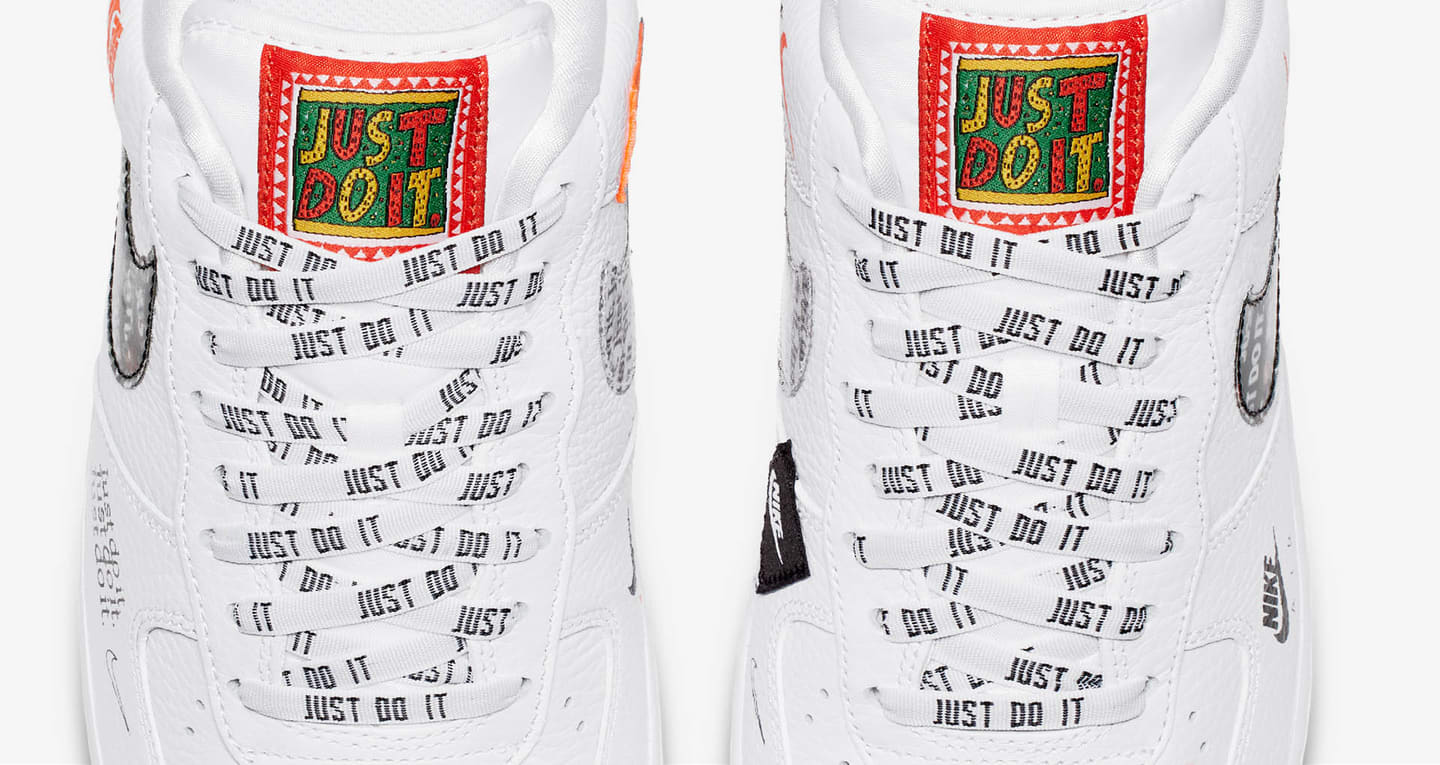
Image Source: Nike
Their marketing consistently promotes self-improvement and achieving one’s full potential. Whether through top-tier athletic training or tenacious perseverance.
This persona comes through in Nike’s motivational “Just Do It” tagline. And its inspirational ad campaigns that celebrate overcoming challenges.
Nike’s tagline, ads, website, and other platforms align with Nike’s mission to bring inspiration to everyone. And help make the impossible possible.
Red Bull
Red Bull’s brand persona is the fun, adventurous friend who encourages you to seize life with vigor. And live on the edge.
Their marketing personifies a lifestyle of intense experiences, risk-taking, and pushing limits. From extreme sports to supernatural feats, Red Bull celebrates those who crave excitement and are unafraid to go big.
You see this daredevil persona embodied in their iconic slogan, “Red Bull Gives You Wiiings,” and advertising full of stunts, races, and death-defying acts.
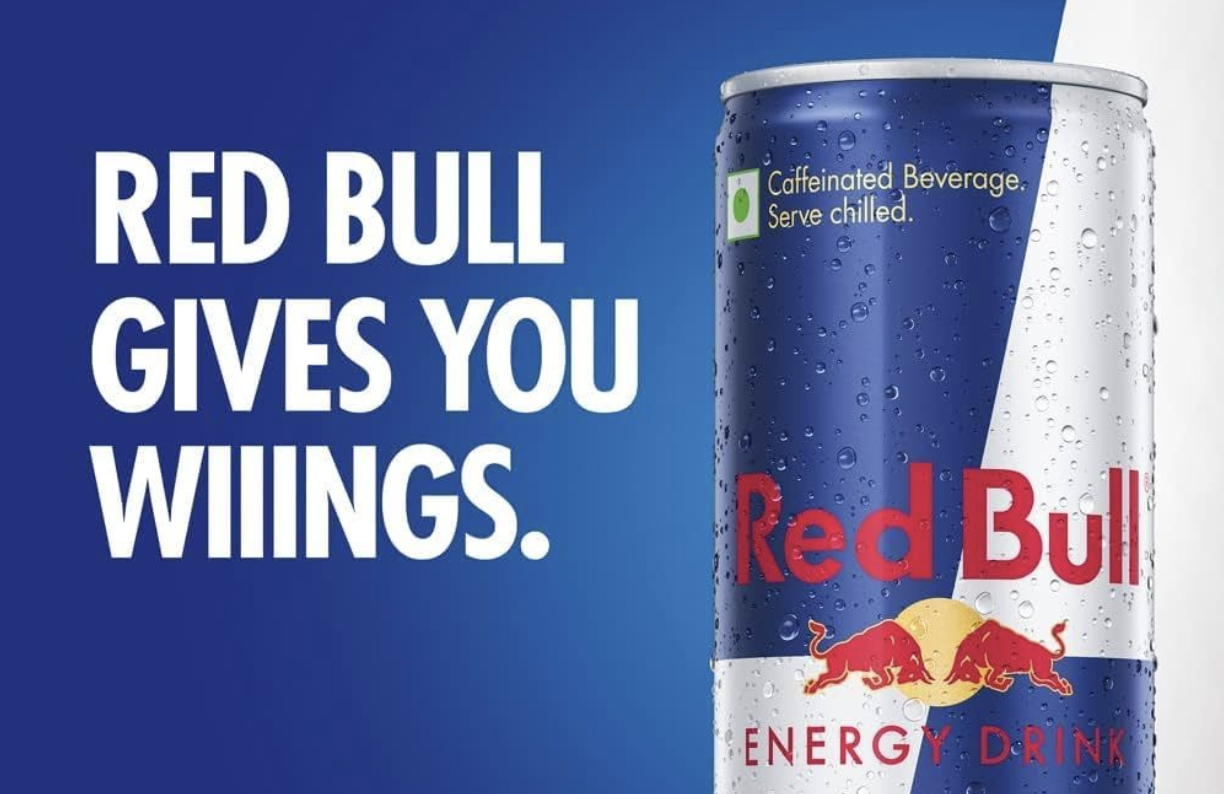
Image Source: LinkedIn
Their sponsored athletes and events like air races, cliff diving, and Crashed Ice epitomize the brand’s thrill-seeking spirit.
Every aspect of Red Bull’s brand—the bright colors, dynamic imagery, and high-energy drinks—aligns with this audacious, boundary-pushing personality.
It creates an aspirational brand experience around living life to the extreme and having the vigor to conquer any challenge.
Starbucks
Starbucks has cultivated a brand persona as the warm, neighborhood third place—a home away from home where everyone is welcome.
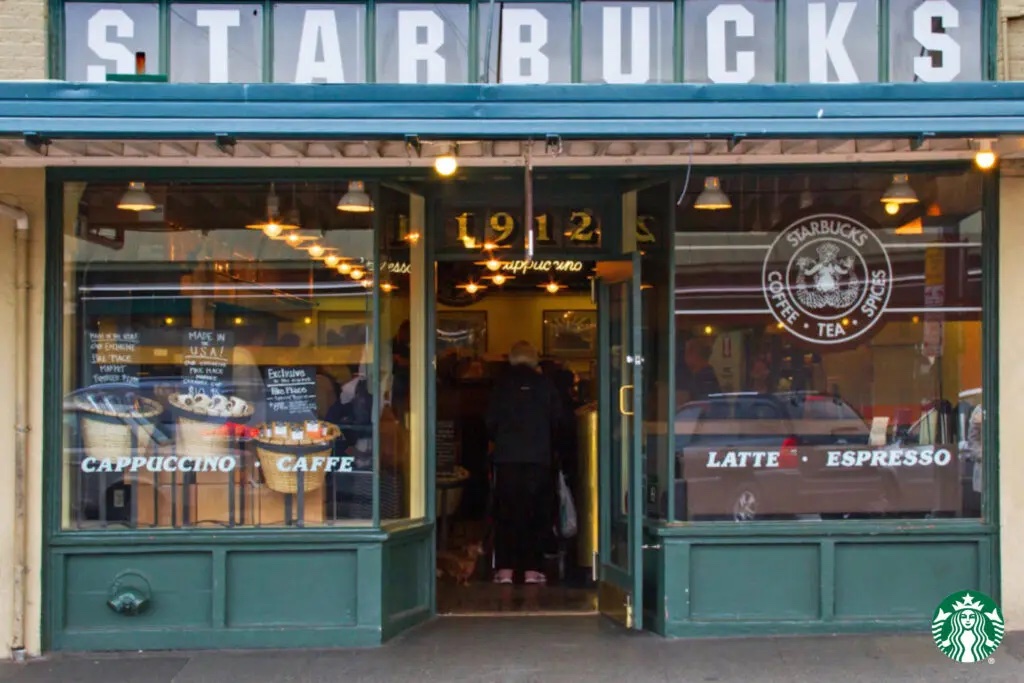
Image Source: Starbucks
Their persona embodies qualities like comfort, community, and human connection.
You see this persona brought to life through Starbucks’ cozy cafe environments designed for lingering, their friendly and outgoing baristas, and marketing that highlights people coming together over coffee.
From the choice of furniture to the curated music playlists, all aspects of the Starbucks experience reinforce their persona as a cozy, comforting “third place” between home and work. It creates an emotionally resonant brand experience that’s about much more than just coffee.
Create an Effective Brand Persona That Resonates With Your Audience
The most recognizable brands have brand personas that their target audience can relate to.
Nike’s inspiring persona resonates with athletes and sports lovers who push themselves to the limit.
Red Bull’s daring persona resonates with athletes who like to do extreme sports.
And Starbucks’s cozy persona resonates with coffee drinkers who want to chill somewhere that’s not work or home.
All three brands learned more about who their target audience is. And developed brand personas that their audience can create emotional connections with. And feel loyal to.
Create a memorable brand that your audience will love and resonate with. By learning more about your target audience with Semrush’s One2Target tool.
Sign up today to get started.



